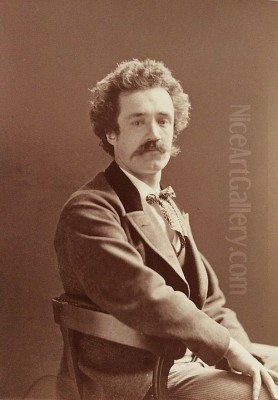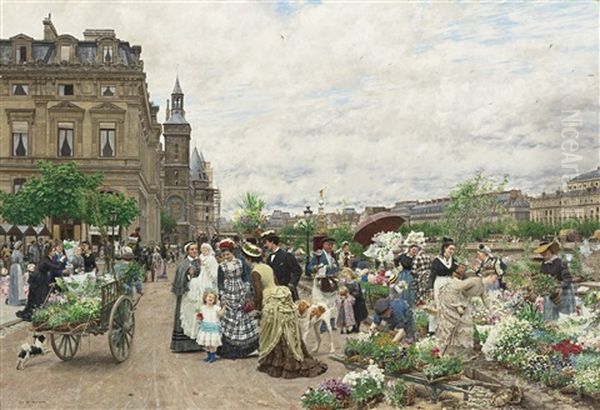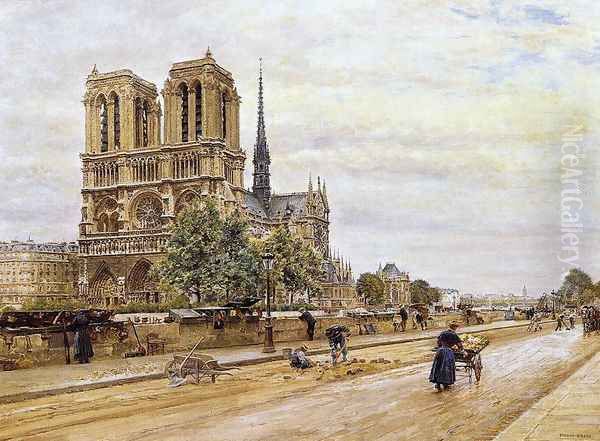
Marie-François Firmin-Girard stands as a fascinating figure in late 19th and early 20th-century French art. Born on May 29, 1838, in the village of Poncin, Ain, and passing away on January 8, 1921, in Montluçon, Allier, his long career spanned a period of immense artistic change. He navigated these transformations with remarkable skill, developing a distinctive style that blended the rigour of academic tradition with the vibrant light and modern subjects favoured by newer movements, carving out a successful and respected place for himself in the bustling Parisian art world.
Firmin-Girard was not merely an observer of his time; he was an active participant and a meticulous chronicler, particularly of the Parisian life that unfolded around him. His canvases capture the elegance, energy, and fleeting moments of the Belle Époque with a clarity and charm that continue to captivate audiences today. While rooted in established techniques, his openness to contemporary influences, including the burgeoning interest in Japanese art, added a unique flavour to his extensive body of work.
Early Life and Academic Foundations
The journey towards artistic prominence began when Firmin-Girard, at the young age of sixteen, left his rural birthplace for the vibrant artistic hub of Paris. His destination was the prestigious École des Beaux-Arts, the cornerstone of official art education in France. There, he entered the ateliers of two highly respected masters: Charles Gleyre and Jean-Léon Gérôme. This training was crucial in shaping his technical proficiency and artistic outlook.
Charles Gleyre, a Swiss-born painter known for his mythological and historical scenes, ran a studio that attracted a diverse group of students. Notably, several future Impressionists, including Claude Monet, Pierre-Auguste Renoir, Alfred Sisley, and Frédéric Bazille, passed through Gleyre's atelier around the same time or shortly after Firmin-Girard. While Firmin-Girard would not follow their radical path, the environment likely exposed him to emerging ideas about light and contemporary subject matter.

Jean-Léon Gérôme, on the other hand, was a towering figure of French Academic painting, renowned for his meticulously detailed historical and Orientalist scenes. Under Gérôme, Firmin-Girard would have honed his skills in precise drawing, complex composition, and achieving a high degree of finish – hallmarks that would remain visible throughout his career, even as his style evolved. This dual tutelage provided him with a solid foundation in traditional techniques while potentially planting seeds of interest in modern life and nuanced observation.
Salon Debut and Early Recognition
Firmin-Girard quickly proved his talent within the competitive environment of the Parisian art scene. He made his official debut at the Paris Salon, the influential annual state-sponsored exhibition, in 1859. His submission was a religious painting, Saint Sébastien (Saint Sebastian), a traditional subject that demonstrated his mastery of academic conventions and anatomical rendering. This debut marked his entry into the professional art world.
His early promise was further confirmed just two years later. In 1861, Firmin-Girard achieved significant recognition by winning the prestigious Second Grand Prix de Rome for painting. The Prix de Rome was the ultimate aspiration for many young artists, offering a funded period of study in Rome. While he secured the second prize, this accomplishment significantly raised his profile and signaled his arrival as a serious talent endorsed by the art establishment. These early successes laid the groundwork for a long and fruitful career exhibiting regularly at the Salon.
Evolving Style: Bridging Tradition and Modernity
Marie-François Firmin-Girard's artistic style is often characterized by its skillful synthesis of different approaches. He remained fundamentally grounded in the academic principles learned under Gleyre and Gérôme, emphasizing strong drawing, balanced composition, and a polished finish. Unlike the core Impressionists who broke radically from these traditions, Firmin-Girard sought to integrate newer sensibilities within this established framework.
His engagement with Realism is evident in his choice of subject matter, particularly his depictions of contemporary Parisian life. He moved beyond purely historical or mythological scenes to capture the world around him – the bustling markets, the fashionable crowds, the quiet moments of daily existence. This focus on the observable, contemporary world aligned him with broader trends in 19th-century art, championed by artists like Gustave Courbet, though Firmin-Girard's interpretation was typically more elegant and less overtly political.

While not an Impressionist in the strict sense – he did not adopt their characteristic broken brushwork or fully dissolve form into light – Firmin-Girard was clearly attuned to their innovations regarding light and colour. His paintings often feature a bright palette, a sensitivity to atmospheric effects, and a convincing depiction of natural light, particularly in his outdoor scenes. He captured the play of sunlight on surfaces and the vibrant hues of flowers and fashion with a freshness that distinguished his work from stricter academic painting.
The Influence of Japonisme
A significant element that adds complexity and charm to Firmin-Girard's work is his engagement with Japonisme – the European fascination with Japanese art and aesthetics that swept through artistic circles in the latter half of the 19th century. Following the opening of Japan to the West, Japanese prints (ukiyo-e), ceramics, textiles, and other crafts flooded European markets, profoundly impacting artists across various movements.
Firmin-Girard absorbed aspects of Japanese aesthetics into his own visual language. This can be seen in certain compositional choices, such as flattened perspectives, asymmetrical arrangements, and the use of decorative patterns, reminiscent of Japanese woodblock prints. Artists like James McNeill Whistler, Edgar Degas, and Félix Bracquemond (whom the source text mentions as a contemporary) were also deeply influenced by Japonisme, each integrating it in their unique ways.
Firmin-Girard's Le Toilette Japonaise from 1873 is a direct example of this interest, depicting a European woman in a setting adorned with Japanese objects. More subtly, the influence appears in the compositional structure and decorative quality of some of his Parisian scenes, adding an exotic or aesthetically refined touch that appealed to the tastes of the era. This incorporation of Japonisme demonstrates his awareness of contemporary trends and his ability to adapt them within his own stylistic framework.
Chronicler of Parisian Life: Subject Matter
While Firmin-Girard began his career with historical and religious subjects, like his debut Saint Sebastian, he became best known and celebrated for his vibrant depictions of contemporary Parisian life. He possessed a keen eye for the details, energy, and social nuances of the French capital during the Belle Époque, a period of relative peace, prosperity, and cultural dynamism before World War I.
His canvases often focus on the bustling public spaces of the city. Flower markets, riverside quays, elegant parks, and fashionable boulevards became his favoured settings. He populated these scenes with Parisians from various walks of life – elegantly dressed ladies, busy vendors, strolling couples, children at play. These genre scenes are rendered with meticulous detail, capturing the fashions, architecture, and atmosphere of the time with remarkable fidelity.
Works like Le Quai aux Fleurs (The Flower Market Quay) are prime examples of this focus. These paintings are more than just topographical records; they are lively vignettes that convey the sensory experience of the city – the riot of colour in the flower stalls, the interplay of light and shadow, the movement of the crowd. Through these works, Firmin-Girard established himself as a visual historian of his era, preserving the ephemeral charm of Belle Époque Paris. He also continued to paint landscapes, often capturing the environs of Paris or scenes from his travels, always with a sensitivity to light and atmosphere.
Analysis of Key Works
Several paintings stand out as representative of Marie-François Firmin-Girard's oeuvre and artistic concerns. Le Quai aux Fleurs, in its various iterations, is perhaps his most iconic subject. These paintings depict the famous flower market on the Île de la Cité in Paris, often bustling with activity. Firmin-Girard masterfully handles the complex composition, balancing the detailed rendering of individual figures and floral arrangements with a sense of overall atmospheric unity. The vibrant colours and the play of light across the scene make it a quintessential example of his ability to capture the charm of everyday Parisian life. It was considered one of his most successful works, both critically and commercially.
Paris, le Quai aux Fleurs au Printemps (Paris, the Flower Market Quay in Spring), dated 1908, showcases his later style. While still detailed, there's perhaps a slightly softer focus on light and atmosphere, capturing the specific quality of a spring day along the Seine. The painting evokes a sense of leisurely enjoyment and the beauty of the city awakening after winter. It highlights his enduring interest in this particular locale and his continued skill in rendering complex urban scenes with vibrancy.
Promenade d'automne (Autumn Stroll) demonstrates his ability to capture seasonal moods and the elegance of outdoor leisure. The painting likely depicts figures enjoying a walk amidst the changing colours of autumn foliage. Such works allowed Firmin-Girard to combine landscape elements with genre observation, focusing on the interplay between figures and their environment, and exploring the specific light and colour palette associated with the season.
His early work, Saint Sébastien (1859), while different in subject matter, is significant as his Salon debut piece. It established his credentials as an artist trained in the academic tradition, capable of handling complex figure painting and historical/religious themes according to the expectations of the official art establishment. Comparing this early work with his later Parisian scenes reveals the evolution of his style and thematic interests over his long career. Le Toilette Japonaise (1873) serves as a clear marker of his engagement with Japonisme, showcasing the incorporation of Japanese motifs and objects popular at the time.
Place in the Contemporary Art World
Firmin-Girard occupied an interesting position within the dynamic art world of late 19th-century Paris. He remained largely faithful to the official Salon system throughout his career, regularly exhibiting his works there and achieving considerable success within that framework. This contrasted with the path taken by the Impressionists (like Monet, Renoir, Pissarro, Degas, and Berthe Morisot), who, frustrated by the Salon's conservative jury, organized their own independent exhibitions starting in 1874.
While Firmin-Girard incorporated elements associated with Impressionism, such as brighter palettes and attention to light, his commitment to detailed rendering and polished finish kept him aligned with more traditional tastes. He found a receptive audience among collectors who appreciated technical skill and charming subject matter but were perhaps not ready for the radical visual language of Impressionism or Post-Impressionism. His teachers, Gérôme and Gleyre, represented the academic establishment, and Firmin-Girard built upon that foundation rather than rejecting it outright.
He was a contemporary of many significant artists. Besides the Impressionists, the art world included prominent academic painters like William-Adolphe Bouguereau and Alexandre Cabanel, who enjoyed immense official success. There were also artists exploring Symbolism, like Gustave Moreau and Pierre Puvis de Chavannes (mentioned in the source text as a contemporary), and others like James Tissot or Alfred Stevens who, similar to Firmin-Girard, specialized in elegant depictions of modern life. His interaction with Félix Bracquemond, a noted printmaker also fascinated by Japonisme, further situates him within the artistic currents of the time.
International Recognition and Later Life
Firmin-Girard's appeal was not limited to France. His detailed and attractive paintings of Parisian life found favour with international collectors, particularly in North America. Wealthy Americans embarking on the Grand Tour or seeking sophisticated European art for their collections were drawn to his work. This international demand contributed significantly to his commercial success and solidified his reputation beyond French borders.
Official accolades continued throughout his career. A notable achievement was winning a silver medal at the Exposition Universelle (World's Fair) held in Paris in 1900. Such awards at major international exhibitions were important markers of an artist's standing and brought further visibility to their work. Firmin-Girard successfully navigated the art market, producing works that were both critically well-received in official circles and commercially desirable.
In his later years, seeking a quieter life away from the hustle and bustle of the capital, Firmin-Girard moved to the town of Montluçon in the Allier department of central France. It was here that he spent his final years, continuing to paint, though perhaps less prolifically. He passed away in Montluçon on January 8, 1921, at the venerable age of 83, leaving behind a substantial legacy of work created over more than six decades.
Market Performance and Legacy
During his lifetime, Marie-François Firmin-Girard enjoyed considerable commercial success. His paintings were popular with bourgeois collectors and international buyers, ensuring a steady demand for his work. In the decades following his death, as artistic tastes shifted dramatically towards Modernism, his style of painting fell somewhat out of fashion, like that of many successful Salon artists of his generation.
However, in recent decades, there has been a renewed appreciation for the art of the Belle Époque and for painters who skillfully captured that era. Consequently, Firmin-Girard's works have performed well on the art market. While major museum pieces are rarely sold, his paintings regularly appear at auction houses in Europe and North America. Prices can vary significantly depending on the size, subject matter, condition, and period of the work.
His bustling Parisian scenes, particularly views of the Flower Market, tend to command the highest prices due to their popularity and intricate detail. Smaller works, studies, or less complex subjects are more accessible. For instance, a work like La Cueillette des Roses (The Rose Picking) was noted to have sold for $3,750 USD at one point, representing the lower end of the market, while more significant canvases can achieve prices well into five or even six figures in US dollars or Euros, demonstrating sustained collector interest. (Note: The extremely high figures mentioned in the initial prompt relating to a 2014 sale appear to be misattributed and likely refer to a different artist, possibly contemporary Chinese, rather than Firmin-Girard).
Firmin-Girard's legacy lies in his ability to create a unique synthesis of artistic styles and in his invaluable contribution as a chronicler of Belle Époque Paris. His work offers a window into a specific time and place, rendered with technical skill and undeniable charm. He successfully bridged the gap between the academic tradition and the emerging modern sensibilities regarding light, colour, and subject matter. His paintings are held in numerous museum collections, including the Musée d'Orsay in Paris, the Musée des Beaux-Arts de Bordeaux, and the museum in his final home town, Montluçon, ensuring his contribution to French art history is preserved and appreciated.
Conclusion: A Distinctive Voice in French Art
Marie-François Firmin-Girard remains a significant artist whose work provides enduring pleasure and historical insight. He navigated the complex artistic landscape of his time with intelligence and skill, absorbing influences from academic training, Realism, Impressionistic light, and Japonisme to forge a style that was distinctly his own. While perhaps not a revolutionary figure in the mold of the Impressionists, he was a master craftsman and a sensitive observer of the world around him.
His depictions of Parisian life, particularly the vibrant scenes of markets and boulevards, stand as his most celebrated achievement. They capture the spirit of the Belle Époque with a combination of meticulous detail and atmospheric charm that continues to resonate. Firmin-Girard's long and productive career demonstrates that artistic success could be found both within and alongside the major movements that defined the era. His work serves as a reminder of the diversity of artistic practice in late 19th and early 20th-century France and secures his place as a respected painter and a valuable visual historian of his time.